Huawei P10 and P10 Plus: Performance & Battery Life Report
by Matt Humrick on May 12, 2017 7:00 AM ESTGPU & Gaming Performance
Previous Kirin SoCs, including the Kirin 955 inside last year’s P9, used smaller GPUs with fewer cores, effectively capping peak performance well below competing flagship phones. The Kirin 960 SoC inside the P10, P10 Plus, and Mate 9 breaks this trend, however. It uses a Mali-G71MP8 GPU based on ARM’s new Bifrost architecture, and while it still processes 1 pixel/texel per clock per core and up to 12 FP32 FMAs per core like the Mali-T880MP4 Midgard GPU in the P9’s Kirin 955 SoC, it uses twice as many cores, giving it a significant advantage in both ALU and texturing throughput.
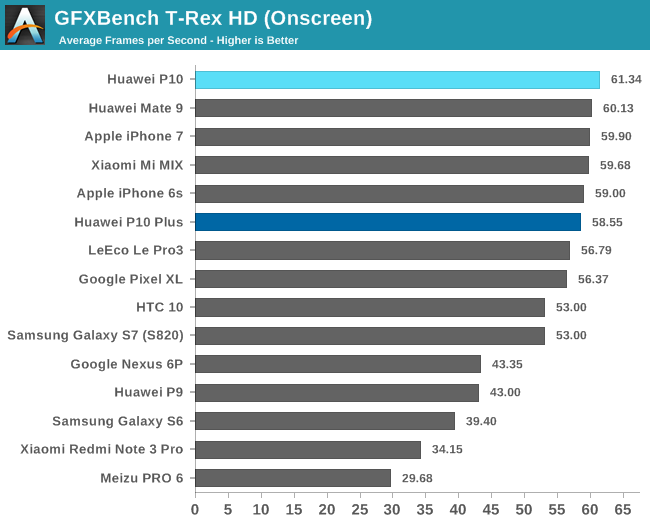
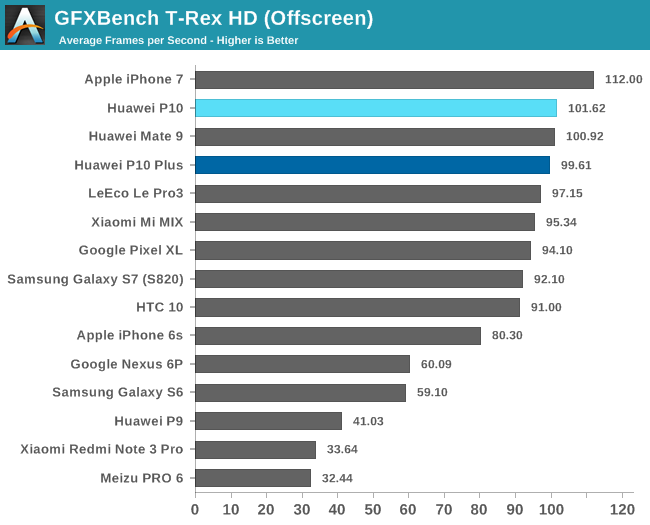
Like most flagship phones today, the P10 has no trouble hitting the 60fps V-Sync limit in the older OpenGL ES 2.0-based GFXBench T-Rex game simulation. Even the P10 Plus with its higher 2560x1440 native resolution averages close to 60fps. When running offscreen at a fixed 1080p resolution, both P10s and the Mate 9 achieve the same score (as expected), which is comparable to phones running Snapdragon 820/821 SoCs.
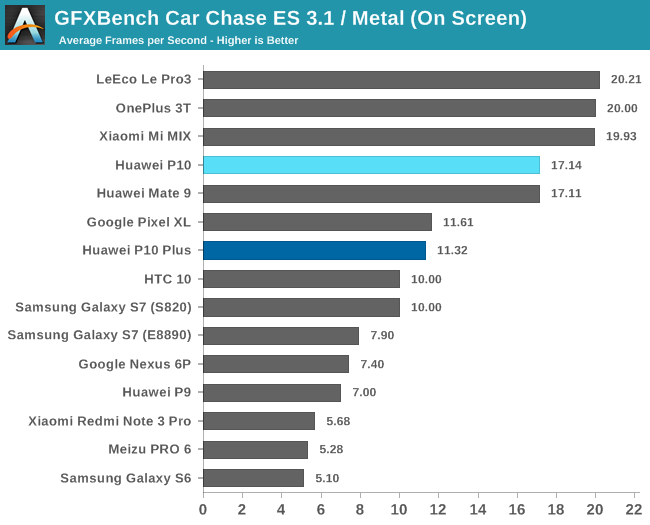
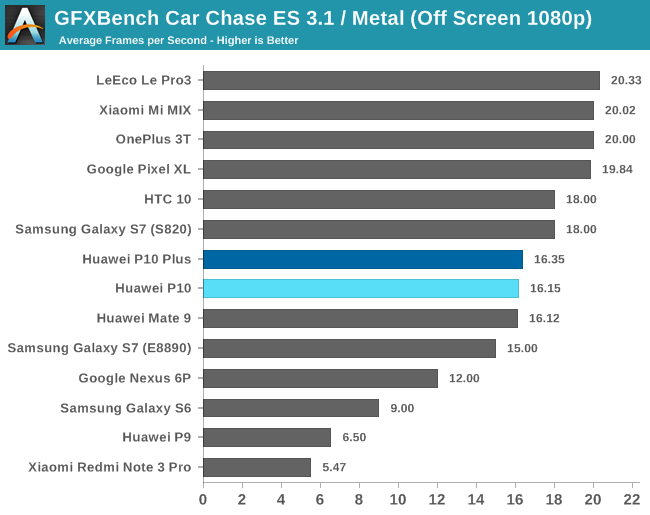
The GFXBench Car Chase game simulation uses a more modern rendering pipeline and the latest features, including tessellation, found in OpenGL ES 3.1 plus Android Extension Pack (AEP). Like many current games, it stresses ALU performance to deliver advanced effects.
Focusing on the offscreen results, there’s no surprises among the phones with Kirin 960. The P10 is about 2.5x faster than the P9, which is a little more than the difference in core count and GPU frequency alone can account for. I noted in the Mate 9 review that one of the biggest changes between ARM’s Midgard and Bifrost architectures is the move away from shader cores that use an SIMD ISA and rely on Instruction Level Parallelism (ILP) to shader cores with a scalar ISA that rely on Thread Level Parallelism (TLP). This change helps Bifrost improve shader core utilization, because it’s much easier to extract TLP from modern game workloads.
These architectural improvements help the P10’s Mali-G71MP8 GPU outpace the older but larger Mali-T880MP12 GPU in the Galaxy S7’s Exynos 8890 SoC, although the P10’s significant frequency advantage (1037MHz vs 650MHz for the S7) also plays a significant role. In this particular ALU-heavy workload, the Adreno 530 GPU in Qualcomm’s Snapdragon 820/821 SoC still comes out on top, however. The LeEco Le Pro3, OnePlus 3T, and Pixel XL all use a newer GPU driver, which allows them to pull ahead of the other Snapdragon 820 phones.
In the onscreen test, the Le Pro3, OnePlus 3T, and Mi MIX, come out on top by combining a Snapdragon 820/821 SoC with slightly lower resolution 1080p displays. The P10 and Mate 9 also have fewer pixels to render than the 1440p P10 Plus, giving them a 51% advantage here.
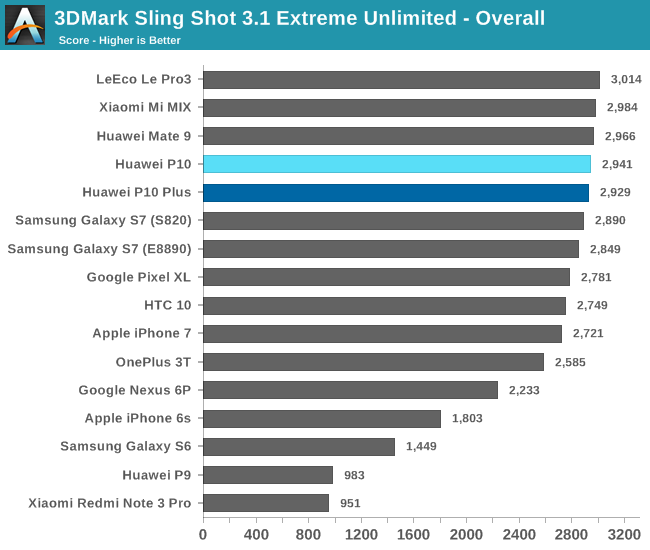
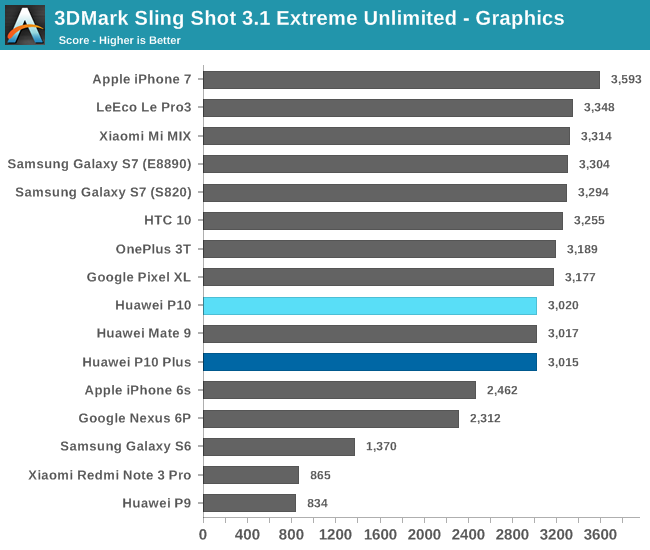

3DMark Sling Shot Extreme uses either OpenGL ES 3.1 on Android or Metal on iOS and stresses the GPU and memory subsystems by rendering offscreen at 1440p (instead of 1080p like our other tests).
There’s only a 17% performance spread across current generation flagship phones, from the LeEco Le Pro3 to the OnePlus 3T, based on the overall score. ARM’s new Bifrost architecture sees an even bigger jump in the 3DMark Sling Shot graphics workloads, showing an 86% improvement over the Midgard GPU architecture in the P9 after applying a 2x scale factor to simulate the difference in core count. There’s still a small 10% gap between the P10 and the Snapdragon 820/821 phones, which get most of their advantage in the second graphics test that emphasizes pixel rather than geometry processing.

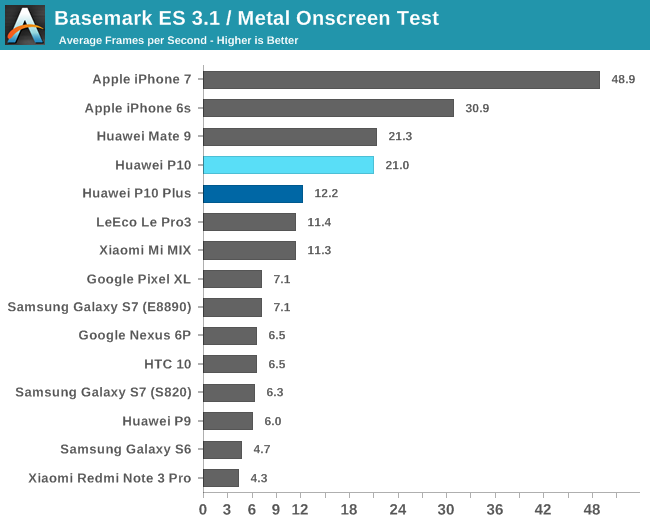
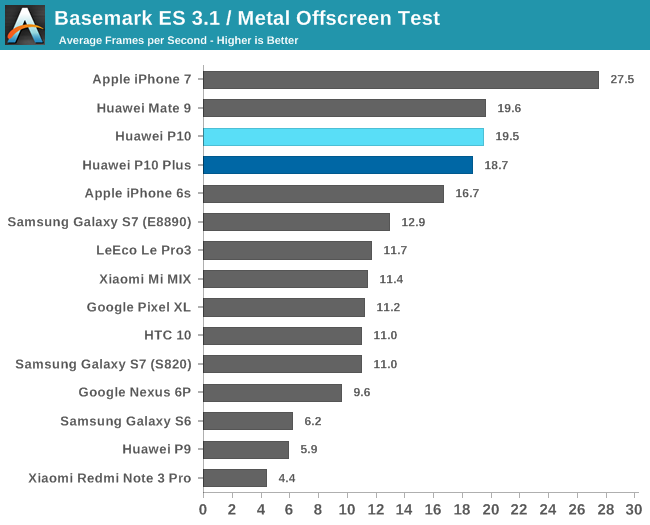
The demanding Basemark ES 3.1 game simulation uses either OpenGL ES 3.1 on Android or Metal on iOS. It includes a number of post-processing, particle, and lighting effects, but does not include tessellation like GFXBench 4.0 Car Chase.
The iPhone 7 takes advantage of Apple’s Metal graphics API, which dramatically reduces driver overhead when issuing draw calls, to pull ahead of the Android phones that are still using OpenGL in this test. While the P10s support Vulkan, a new low-level graphics API that has similar benefits to Apple’s Metal, benchmark and game support is taking longer to materialize. We should see it in action later this year, though.
The two P10s do very well in this test, placing ahead of the Exynos 8890 version of the Galaxy S7 by 52% and the Snapdragon 820 version by 78%. Even though we’ve seen the Adreno 530 GPU perform well in our other tests, it’s interesting to see it fall behind the Mali GPUs in this workload.
As expected, both the P10 and P10 Plus perform just as well as the Mate 9, all of which are using LPDDR4 RAM. Doubling the number of shader cores and switching from the Midgard to the Bifrost GPU architecture significantly improves peak performance over the previous generation, and puts the P10 in the same league as other current flagship phones.










74 Comments
View All Comments
John Other - Sunday, May 14, 2017 - link
I've not used the Pixel, but can confirm that my P10 is really very smooth and responsive and a pleasure in general use.But I can absolutely imagine that with the OS familiarity Google has, on the same hardware, battery smoothness is entirely possible. Gratuitous car analogy: Mercedes-Benz not quite a Bentley.
On the other side of the coin, I think the physical build, first rate certainly, you will be able to sense as short of a iPhone 7, if you ever once use the iPhone for a while. The iPhone has the better mass distribution of the two, the P10 just a touch weighted on the left. It may be my recovering hand from injury that makes my hold less secure than before, but I went to a store specifically to jog my recollection. IPhone definitely wins in the purely illusory feeling of security in holding balance. I caveat this with the fact that during recovery from my hand in which my index finger was badly broken, I perceived that perfectly flat items like credit cards I gripped were concave. So my touch is not calibrated. However the impression I relate is that which I went to check only last week.
I should further note that my P10 replaced my LUMIA 650. This was too close a call entirely due to the LUMIA 950 XL making the only sensible decision that just does not feel sensible any longer. Other than the state of hardware, and sorely needed Edge advancements, the switch from Windows 10 Creator's Mobile, is one I simply would not have called, was a Microsoft direction visible. I think it is testimony to Steve Ballmer, how much survived, superannuated, that remains very good. Nadella appears to have had to asphyxiate the Ball er legacy plans, as if he couldn't present good reason to shut them down. Microsoft have forgotten that cutting off the air supply is supposed to be done to the competition.... But if Windows Phone is the price of maturing beyond that level of aggression, in a market where we need software integration absent hardware leaps, to drive performance, then so be it. Just to not tell the world, of such a positive game plan, beats me.
Speedfriend - Friday, May 12, 2017 - link
The thought that you can buy a product that may be totally different to the review that you have read is crazy. They should be punished by no one buying themphilehidiot - Friday, May 12, 2017 - link
Indeed - I find it very disturbing that the phones could be either a modern spec (and I have to assume Anandtech were supplied with the best possible article) or falling behind even last generation in some areas. There's a difference between SoCs which are binned and fall within a bell curve and totally different components. Yes, the difference now might be marginal in terms of experience but as software becomes more hardware intensive you expect that perceptive performance to be maintained for a reasonable timeframe - this is one reason why you're paying double for a flagship phone.I'm sorry but if someone offered me a PC and it could come with either a HDD or SSD or DDR3 or DDR4 depending on luck and oh, by the way the cost is the same regardless of what you get and we won't tell you, you'll just have to find out when you get it.... I'd tell them to fuck off. It's an absolute disgrace and sticking two fingers up at your customer. I understand there are shortages and intense competition but if you're going to do this then you DROP YOUR PRICES! You can't charge the same as a modern flagship with the risk of getting components 1-2 years out of date (relative to flagship specification).
In addition to this, you have to consider optimisation may well suffer. You've got a closed system with components all working on one system (UFS) for example and you can spend time optimising everything to work with that. Suddenly, due to suppliers, you have to optimise late in the design phase (probably when mass production techniques have already been devised and they're now looking at supply - I assume, I'm not in the industry, let me know if I'm wrong) for not just UFS but eMMC as well which adds complexity and potentially adds bugs. As WELL as slowing down updates as they end up more complex.
If you're going to violate your customers like this then you have to offer them something in return, ideally reduced cost. They are competing with standardised flagships on price and, whilst I was very interested, knowing I could be getting something markedly different to what I'm paying for makes this brand a no, no for me.
"Yes, sir, you ordered the caviar"
"Well, I appear to have a pear with a turd next to it"
"Sorry, Sir this is how our restaurant operates. We can't always get supply in to meet demand so we carry on charging the same but give you what you'd get in a dirty cafe."
"Well, I'm sorry, I'm returning this and I want a refund"
"Sorry, Sir... it did not say anywhere that you wouldn't get a pear instead and you ARE being provided with something that came out of an animal, so you have no grounds for complaint"
"Oh you can just fu......"
John Other - Sunday, May 14, 2017 - link
The P10 is by far the most modestly priced of the flagships.UK retail carrier unlocked, I think dropped below pounds 600 last week.
I find that I am soundly impressed with the understatement of this phone. Everything about it infuses me with confidence. Only a removable battery, would be my request. (for which surely there must be a elegant engineering solution (plastic backs are decades behind the build quality we expect from any other than budget categories, and the semi liquid packed character must be solvable, alongside a truly solid attachment mechanism, clip on flush not insert and cover)
I can't compare but watching the Formula One qualifying sessions yesterday, on Now TV over LTE, the sound was of a quality comfortably filling my small hotel room, all 4 by 5 yards of it, and I could make out the transmission artefacts hampered car to pit radio, and even the transmission of the cars in corners, on the internal speaker. If this is the general quality to expect nowadays, we're doing well, I don't see the need to be gloomy about the market demand for upgrades etc.
fanofanand - Friday, May 12, 2017 - link
Very generous of you to assume that the gimped phones will still be fine and dandy for the end consumer. You seem to be forgiving of the practice, or at least understanding. I am not. If you can't procure the parts you don't sell the product. This kind of bait and switch is precisely the kind of thing people will point to when they say they will "never buy a chinese phone"Matt Humrick - Friday, May 12, 2017 - link
It's not that I condone the practice, I just want people to understand that this happens frequently and why it happens. I've seen LG use display panels of significantly different quality in its G-series phones, and Samsung use different camera sensors (with equivalent specs) on its Galaxy phones that produce images that look completely different, for example. So the P10 is not even the worst example of multi-sourcing. Huawei needs to be more truthful in its advertising, though.invinciblegod - Friday, May 12, 2017 - link
Apple did something similar where the SOC was manufactured by Samsung or TSMC. Apparently, the TSMC one was slightly better but only marginally.levizx - Friday, May 12, 2017 - link
No, not even remotely close. A9 was merely manufactured by different foundries, they have identical design and spec and are pin-to-pin compatible. Difference is only the average power consumption, but even chips cut from the same wafer have different power consumption.eMMC/UFS2.x OTOH are incompatible standards, they don't resemble each other in any way.
levizx - Friday, May 12, 2017 - link
Problem is QUALITY aside, different suppliers still have nominally similar specs, ie all IPS LCD, same sensor size & pixel count.Now, I can understand mixing UFS 2.0/2.1 since they have similar specs and can nominally perform similarly.
eMMC 5.1 is a totally different standard/interface. I'll be replacing AMOLED with TN LCD.
drajitshnew - Saturday, May 13, 2017 - link
Matt I was very interested when I started the review, but lost most of my interest when the variability was revealed. Then on I just skimmed through the review.What is the point of the review if the system YOU purchase could have memory a generation behind, storage 2 generations behind, and a different bin of processor? There was a quite a ruckus when apple dual sourced CPUs with marginally different preformed.
At the very least either you or your should add caveat emptor or YMMV, in BIG BOLD letters to the end of the review. The reputation of anandtech.com deserves at least that.